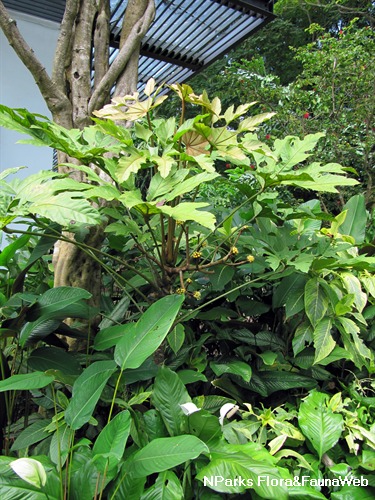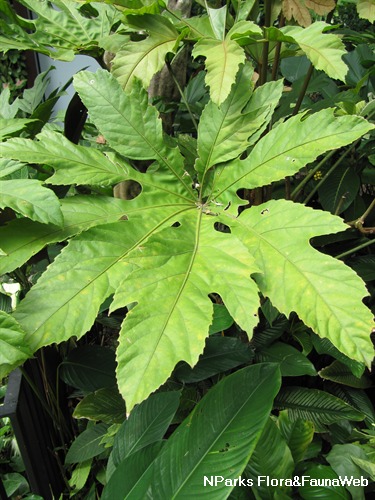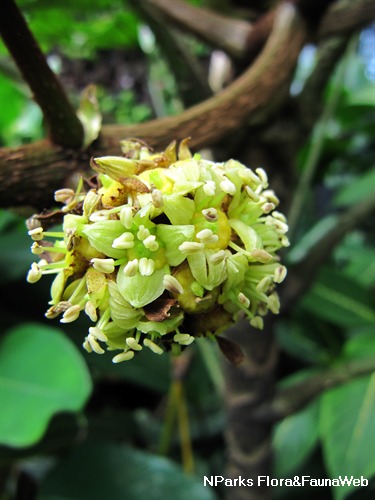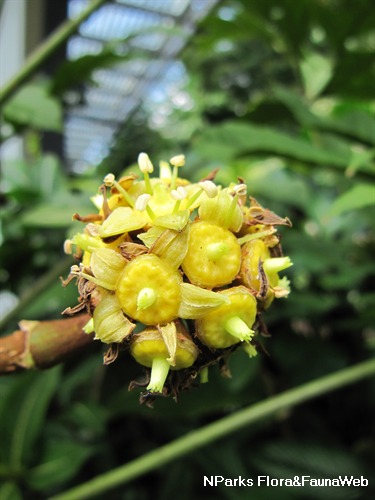
Back
Trevesia palmata (Roxb. ex Lindl.) Vis.
| Family Name: | Araliaceae |
| Synonyms: | Gastonia palmata Roxb. ex Lindl., Brassaiopsis papayoides Handel-Mazzetti, Fatsia cavaleriei H. Léveillé, Plerandra jatrophifolia Hance, Trevesia cavaleriei (H. Léveillé) Grushvitzky & Skvortsova, Trevesia palmata var. costata |
| Common Name: | Snowflake Aralia, Snowflake Plant |
Name
Classifications and Characteristics
| Plant Division | Angiosperms (Flowering Seed Plants) (Dicotyledon) |
|---|---|
| Plant Growth Form | Tree (Small (6m-15m)) |
| Lifespan (in Singapore) | Perennial |
| Mode of Nutrition | Autotrophic |
| Maximum Height | 8 m |
Biogeography
| Native Distribution | Bangladesh, Cambodia, India, Laos, Nepal, Southern China, Thailand, and Vietnam |
|---|---|
| Native Habitat | Terrestrial (Primary Rainforest, Mountain, Secondary Rainforest) |
| Preferred Climate Zone | Sub-Tropical / Monsoonal |
| Local Conservation Status | Non-native (Horticultural / Cultivated Only) |
Description and Ethnobotany
| Growth Form | It is a small tree, up to 8 m tall. |
|---|---|
| Trunk | Its trunk reaches up to 15 cm in diameter. The branches are prickly and pubescent. |
| Foliage | Its simple, alternately-arranged, stalked leaves are 5-9-lobed, each lobe being narrowly ovate-lanceolate, with serrated edges. The entire leaf blade is about 60-90 cm wide. Its petioles are prickly. |
| Flowers | Its flowers are arranged in a large panicle of umbels, about 45 cm wide. |
| Fruit | Its fruits are somewhat round, 1-1.8 cm wide. |
| Habitat | It grows in forests on mountain slopes. |
| Cultivation | It can be propagate by seeds. |
| Etymology | Latin Trevesia, after Treves de Bonfigli of Padua; Latin palmata, having five or more veins arising from one point, hand-shaped, referring to the lobed leaves that look like a hand. |
Landscaping Features
| Landscaping | It is suitable for growing in parks and gardens for its attractive foliage. |
|---|---|
| Desirable Plant Features | Ornamental Foliage |
| Landscape Uses | Parks & Gardens |
Fauna, Pollination and Dispersal
| Pollination Method(s) | Biotic (Fauna) |
|---|
Plant Care and Propagation
| Light Preference | Full Sun, Semi-Shade |
|---|---|
| Water Preference | Moderate Water |
| Plant Growth Rate | Moderate |
| Rootzone Tolerance | Moist Soils, Well-Drained Soils, Fertile Loamy Soils |
| Maintenance Requirements | Moderate |
| Propagation Method | Seed |
Foliar
| Foliage Retention | Evergreen |
|---|---|
| Mature Foliage Colour(s) | Green |
| Mature Foliage Texture(s) | Hairy / Hirsute, Leathery |
| Foliar Type | Simple / Unifoliate |
| Foliar Arrangement Along Stem | Alternate |
| Foliar Attachment to Stem | Petiolate |
| Foliar Shape(s) | Non-Palm Foliage (Palmate) |
| Foliar Venation | Pinnate / Net |
| Foliar Margin | Serrate / Toothed |
Floral (Angiosperm)
| Flower & Plant Sexuality | Bisexual Flowers |
| Flower Grouping | Cluster / Inflorescence |
|---|---|
| Flower Location | Axillary |
Fruit, Seed and Spore
| Fruit Classification | Simple Fruit |
|---|---|
| Fruit Type | Fleshy Fruit , Non-Accessory Fruit |
Image Repository
Others
| Master ID | 30492 |
|---|---|
| Species ID | 4801 |
| Flora Disclaimer | The information in this website has been compiled from reliable sources, such as reference works on medicinal plants. It is not a substitute for medical advice or treatment and NParks does not purport to provide any medical advice. Readers should always consult his/her physician before using or consuming a plant for medicinal purposes. |




